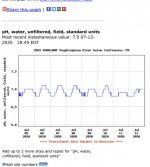The single biggest detriment to the river that may actually have a hope of being addressed is with flow management. We run out of cold water around August every year, and don't get good temps back until the Casselman cools sometime in October.
It just so happens that the Army Corps is seeking public comments on the Yough Master Plan until August 7. This could be the chance to provide some input, or at least let them know that people care: https://triblive.com/local/regional/u-s-army-corps-seeking-input-on-youghiogheny-river-lake-master-plan/
The purpose of the dam is flood protection, but everyone is well aware of the summer bumps that are provided to support rafting. Some creative management of flows (even from the other flood protection projects in the region) could help to better manage flows, and perhaps improve the fishery.
There's also an issue with PFBC that hasn't gotten a ton of attention. They have largely been hands-off with the river. Look at the survey data, and it will tell you all that you need to know. PFBC surveyed in '89, '94, and 2012. They also did so using sampling gear that had significant limitations (particularly on the coldwater sections) which likely limited the accuracy of the surveys. You don't have to be a stats expert to understand that a limited sample size isn't going to give you representative data, yet they make management decisions based off of those events. For instance, a few years back, they shifted the percentage of rainbow/brown fingerlings from an even split, to one that favors more rainbows, because "rainbows do better in the river". That's straight from Rick Lorson's mouth, and somewhat contrary to what we've seen over the years. Again, this is based off of 3 sampling events that stretched over a 23 year time period where the river has made significant gains in water quality and bug life (whoever posted that there is limited bug life in the river needs to have their vision checked, or maybe fish the river more).
The warmwater portion of the river mostly takes care of itself, but for the life of me, I can't understand why the coldwater portions of the river haven't been given the attention they deserve from a management perspective. It's a unique, big river, that is floatable through predominantly public land. On top of that, it's in close proximity to several major population centers, and keeps cold water when nearly everything else is drying up. You would think this would be a river that they would want to put a spotlight on. Yet, PFBC and DCNR do very little to learn about what is there, manage it appropriately, and facilitate access. It's maddening...




